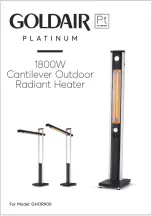
6
TNR-I&S-02
VENTING
CAUTION
The vent shall terminate a minimum of 12 inches above expected
snowfall level to prevent blockage of vent termination.
The horizontal centerline of the exhaust vent terminal (if applicable)
must not be located lower than the horizontal centerline of the air
intake terminal if vented through the same wall.
A service drain loop must be installed in the drain tubing to serve as
a condensate trap to prevent flue gases from escaping in the room.
DO NOT position air intake terminal above exhaust terminal.
NEVER locate air intake terminal when exhaust gases can be introduced.
The venting instructions must be followed to avoid restricted combustion
or recirculation of flue gases. Such conditions cause sooting or risks of fire
and asphyxiation.
This water heater can be installed as either a direct vent system or power
vent (air from inside) system. If it is installed as a direct vent system,
then the air intake and the exhaust vent are piped to the outside. If a
power vented system is used, then air is drawn from inside and only the
exhaust is piped to the outside. Determine which system is best for your
application and install as described in the following sections.
DIRECT VENT INSTALLATION
Venting may be run horizontally through an outside wall or vertically
through a roof through using either 3 inch (7.6 cm) or 4 inch (10.2 cm)
diameter PVC or CPVC pipe. This water heater is supplied with a 3 inch PVC
screened intake and exhaust 90° elbow referred to as the exhaust vent
terminal and the air intake terminal.
NOTICE
Before beginning installation of any vent pipe, read the vent pipe
manufacturer’s installation instructions.
Water heater must be protected from freezing downdrafts during
shutdown periods.
Provide protection of the building materials from degradation by flue
gases from the exhaust vent terminal.
WARNING
The vent system must be properly installed. Failure to properly install
the vent system could result in property damage, personal injury, or
death.
DO NOT
install damaged venting system components. If damage is
evident then please contact the supplier where the water heater was
purchased or the manufacturer listed on the rating plate for
replacement parts.
Use only the vent terminals provided or factory authorized terminals
for venting this water heater.
The water heater requires its own separate venting system. Do not
connect the exhaust vent into an existing vent pipe or chimney.
All of the exhaust venting connections must be leak checked with a
soap solution upon initial start up of the water heater. Any leaks must
be repaired before continuing operation of the water heater.
Do not terminate the venting where noise from the exhaust or intake
will be objectionable. This includes locations close to or across from
windows and doors. Avoid anchoring the vent and intake pipes directly
to framed walls, floors, or ceilings unless rubber isolation pipe hangers
are used. This prevents any vibrations from being transmitted into the
living spaces.
Do not exceed the venting distances or the number of elbows listed in
this manual. Exceeding the maximum venting distances may cause
the water heater to malfunction or cause an unsafe condition.
DO NOT operate this water heater until the venting installation is
complete and the piping completed. Failure to complete installation
before operation can result in property damage, personal injury, or
death.
Figure 9 Typical Plumbing Schematic for Zoned Heating
TuboCharger Water Heater






































